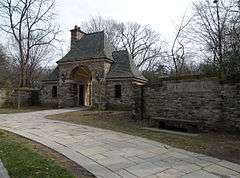Frick Park
| Frick Park | |
|---|---|
|
Reynolds St. Entrance | |
| Type | Municipal Park |
| Location | Pittsburgh, Pennsylvania |
| Coordinates | 40°25′56″N 79°54′18″W / 40.432314°N 79.904904°W |
| Area | 644 acres (2.61 km2) |
| Created | 1919 |
| Operated by | City of Pittsburgh Citiparks, Pittsburgh Parks Conservancy |
| Website | www.pittsburghparks.org/frick |
Frick Park is the largest municipal park in Pittsburgh, Pennsylvania, covering 644 acres (2.61 km2). It is one of Pittsburgh's four historic large parks.
The park began when Henry Clay Frick, upon his death in 1919, bequeathed 151 acres (0.61 km2) south of Clayton, his Point Breeze mansion (which is now part of the Frick Art & Historical Center). He also arranged for a $2 million trust fund ($27.3 million today) for long-term maintenance for the park, which opened on June 25, 1927. He did this against his will, but rather acquiesced to his daughter, Helen's debutante wish which he had promised to honor.[1]
Henry Clay Frick's son, Childs Frick, developed his lifelong love of animals in the woods and ravines of the park. Childs Frick went on to be a renowned American vertebrate paleontologist, major benefactor and trustee of the American Museum of Natural History.
Over the years, the park grew from the original land in Point Breeze and now includes Squirrel Hill to the border of Edgewood. It is one of the few areas of a city that Frick helped industrialize, where steep ravines and mature woods remain relatively undisturbed, forming a nature reserve of native plants and abundant wildlife. Owls, amphibians, wild turkey, fox, and many mammal species are found in the park.
Frick Environmental Center
During construction, the Frick Environmental Center is operating out of the Blue Slide Park entrance of Frick Park in Squirrel Hill.
Fire
In 2002, the old Frick Environmental Center, a wooden structure located just inside the park entrance caught fire, rendering the structure functionally unusable. The center offers programs about the park's habitats and ecology, including the park's 151-acre Frick Woods Nature Reserve. In 2006, the City of Pittsburgh Public Parks purchased 2 70 ft. by 20 ft. trailer and placed them near the park entrance.
Rebuilding
Talk of rebuilding the Frick Environmental Center began following the burning of the center. The City of Pittsburgh, The Pittsburgh Parks Conservancy, and interested community members worked together to come up with a design for the new building and grounds. In late 2013, the Pittsburgh Parks Conservancy and the City of Pittsburgh signed an operating agreement for the 115 acres surrounding the Environmental Center. The building will stand at the same spot as the old environmental center, produce all of its energy, collect rainwater, and be LEED certified. Demolition at the site was completed and construction began in late-2014.
Ecology of Frick Park
The eastern park boundary is Nine Mile Run, a formerly heavily polluted stream that has been restored to its natural beauty with an innovative water catchment design, extending Frick Park nearly to the mouth of Nine Mile Run at the Monongahela River.
Blue Slide Playground
In the section of the park located near the corner of Beechwood Boulevard and English Lane, there is a playground with a blue slide going down a steep hill and that playground is therefore known as the blue slide park.
Sledding on this hill is a very popular winter pastime for many people who live nearby. The hill's long, sloping bowl ends in a grouping of trees. Two different approaches down the hill – one shallow and one steep – intersect at the bottom, occasionally resulting in collisions between sledders. Crashing into trees is also an occasional occurrence. As a result, the city posted "no sledding" signs for liability reasons.[2]
Frick Park in popular media
Pittsburgh rapper Mac Miller's album Blue Slide Park, the first indie top of the charts recording in a quarter of a century, is named for this playground. The song Frick Park Market is likewise named for a small store near the Point Breeze park boundary.
References
- ↑ Frick Park Clay Court Tennis Club history
- ↑ City tries to put the skids on sledding in Frick Park, Pittsburgh Post-Gazette, January 13, 2010
External links
| Wikimedia Commons has media related to Frick Park (Pittsburgh, Pennsylvania). |
- Pittsburgh Parks Conservancy
- Pittsburgh Dept. of Parks & Recreation website
- Frick Park Clay Court Tennis Club history
